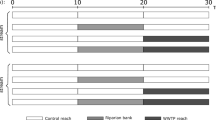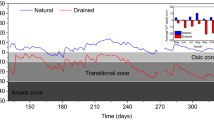Abstract
Large areas of mangroves in India are heavily disturbed by cattle grazing, hypersalinity, and other human-induced impacts. In two disturbed Avicennia marina forests and two undisturbed A. marina and Rhizophora apiculata forests in the Pichavaram mangroves of the Vellar–Coleroon estuarine complex, southeast India, we measured the rates and pathways of microbial decomposition of soil organic matter to determine if human impact is altering biogeochemical activity within these stands. Rates of total carbon oxidation (TCOX) were higher in the undisturbed A. marina forest (mean 199 mol C m−2 year−1) than in the two impacted stands (43 and 79 mol C m−2 year−1); rates of total carbon oxidation in the R. apiculata forest averaged 75 mol C m−2 year−1. Sulphate reduction (range 21–319 mmol S m−2 day−1) was the major decomposition pathway (65–85% of TCOX), except at the most disturbed forest (30% of TCOX). Rates of sulphate reduction at all sites peaked in sub-surface soils to a depth of about 1 m, leading to little carbon burial (3–5% of total C input). There was some evidence of measurable iron and manganese reduction in association with tree roots. Rates of microbial activity were rapid in comparison with rates measured in other mangrove soils, reflecting high rates of phytoplankton production and organic matter retention in this lagoon. Human-induced disturbance creates a sharp zonation of dry, hypersaline soil overlying less saline, wetter soil, suppressing surface microbial and root growth. We conclude that this vertical alteration of soil characteristics and biogeochemistry shifts the cycling of nutrients between trees and microbes to a disequilibrium state, partly explaining why mangroves are stunted in these declining forests.








Similar content being viewed by others
References
Alongi DM, Tirendi F, Trott LA, Xuan XX (2000) Benthic decomposition rates and pathways in plantations of the mangrove, Rhizophora apiculata, in the Mekong delta, Vietnam. Mar Ecol Prog Ser 194:87–101
Alongi DM, Wattayakorn G, Pfitzner J, Tirendi F, Zagorskis I, Brunskill GJ, Davidson A, Clough BF (2001) Organic carbon accumulation and metabolic pathways in sediments of mangrove forests in southern Thailand. Mar Geol 179:85–103
Alongi DM, Wattayakorn G, Tirendi F, Dixon P (2004) Nutrient capital in different aged forests of the mangrove Rhizophora apiculata. Bot Mar 47:116–124
Berner RA (1980) Early diagenesis: a theoretical approach. Princeton University Press, Princeton, NJ
Boto KG (1992) Nutrients and mangroves. In: Connell DW, Hawker DW (eds) Pollution in tropical aquatic systems. CRC Press, Boca Raton, FL, pp 129–145
Canfield DE (1993) Organic matter oxidation in marine sediments. In: Wollast R, MacKenzie, FT, Chou, L (eds) Interactions of C, N, P and S in biogeochemical cycles and global change. Springer, Berlin Heidelberg New York, pp 333–363
Fossing HR, Jorgensen BB (1989) Measurement of bacterial sulphate reduction in sediments: evaluation of a single-step chromium reduction method. Biogeochemistry 8:205–222
Fu CB, Kim J-W, Zhao ZC (1998) Preliminary assessment of impacts of global change on Asia. In Galloway JN, Melillo JM (eds) Asian change in the context of global climate change. Cambridge University Press, Cambridge, pp 308–342
Hall POJ, Aller RC (1992) Rapid, small-volume flow injection analysis for ∑CO2 and NH4+ in marine and freshwaters. Limnol Oceanogr 37:1113–1118
Kathiresan K (2000) A review of studies on Pichavaram mangrove, southeast India. Hydrobiologia 430:185–205
Krishnamurthy K, Jeyaseelan MJP (1983) The Pitchavaram (India) mangrove ecosystem. Int J Ecol Environ Sci 9:79–85
Kristensen E, Andersen FO, Holmboe N, Holmer M, Thongtham N (2000) Carbon and nitrogen mineralization in sediments of the Bangrong mangrove area, Phuket, Thailand. Aquat Microb Ecol 22:199–213
Lacerda LD (1997) Trace metals in mangrove plants: why such low concentrations? In: Kjerfve B, Lacerda LD, Diop EHS (eds) Mangrove ecosystem studies in Latin America and Africa. UNESCO, Paris, pp 171–190
Lacerda LD, Carvalho CEV, Tanizaki KF, Ovalle ARC, Rezende CE (1993) The biogeochemistry and trace metal distribution of mangrove rhizospheres. Biotropica 25:252–257
Loring DH, Rantala RTT (1992) Manual for the geochemical analyses of marine sediments and suspended particulate matter. Earth Sci Rev 32:235–283
Nedwell DB, Blackburn TH, Wiebe WJ (1994) Dynamic nature of the turnover of organic carbon, nitrogen and sulphur in the sediments of a Jamaican mangrove forest. Mar Ecol Prog Ser 110:223–231
Purvaja R, Ramesh R, Frenzel P (2004) Plant-mediated methane emission from an Indian mangrove. Global Change Biol 10:1825–1834
Ramanathan AL (1997) Sediment characteristics of the Pichavaram mangrove environment, south east coast of India. Indian J Mar Sci 26:319–322
Ramesh R (2003) Land use in coastal ecosystems and its implication on nutrient biogeochemistry. In: Ramesh R, Ramachandran S (eds) Coastal urban environments. Capital, New Delhi, pp 39–46
Ryle VD, Wellington JT (1982) Reduction column for automated determination of nitrates. Analytical laboratory note no. 19. Australian Institute of Marine Science, Townsville, QLD
Ryle VD, Mueller HR, Gentien P (1981) Automated analysis of nutrients in tropical seawater. Monograph OS-81-4. Australian Institute of Marine Science Monograph Series, Townsville, QLD
Saenger P (2002) Mangrove ecology, silviculture and conservation. Kluwer, Dordrecht
Sokal RR, Rohlf FJ (1995) Biometry, 3rd edn. Freeman, New York
Subramanian AN (2004) Status of Indian mangroves: pollution status of the Pichavaram mangrove area, south-east coast of India. In: Vannucci M (ed) Mangrove management & conservation. United Nations University Press, Tokyo, pp 59–75
UNESCO (1985) The international system of units (SI) in oceanography. UNESCO technical papers in marine science no. 45. UNESCO, Paris
Acknowledgements
This study was supported by a grant from the Australia–India Council (D.M. Alongi, principal investigator) and the Australian Institute of Marine Science (AIMS). We thank the staff and students of the Marine Biological Laboratory at Parangipettai for their help and forbearance. P. Dixon, S. Boyle, and C. Payn of AIMS helped with laboratory analyses.
Author information
Authors and Affiliations
Corresponding author
Additional information
Communicated by G. F. Humphrey, Sydney
Rights and permissions
About this article
Cite this article
Alongi, D.M., Ramanathan, A.L., Kannan, L. et al. Influence of human-induced disturbance on benthic microbial metabolism in the Pichavaram mangroves, Vellar–Coleroon estuarine complex, India. Marine Biology 147, 1033–1044 (2005). https://doi.org/10.1007/s00227-005-1634-5
Received:
Accepted:
Published:
Issue Date:
DOI: https://doi.org/10.1007/s00227-005-1634-5




